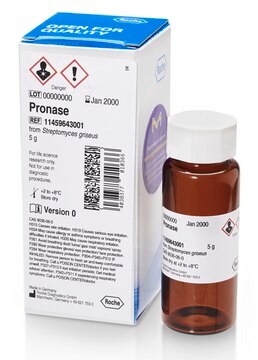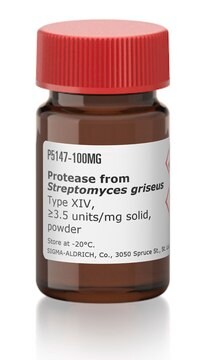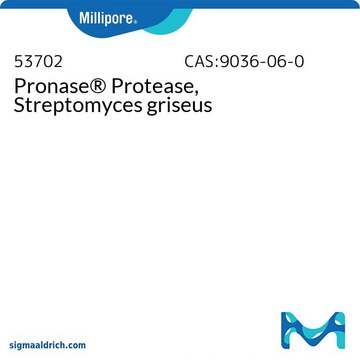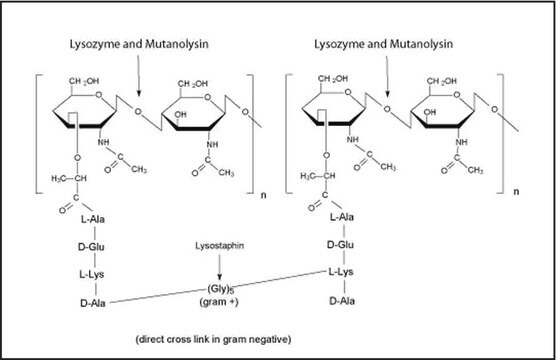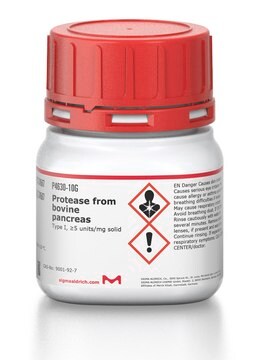About This Item
Polecane produkty
pochodzenie biologiczne
Streptomyces griseus
Postać
fine powder
producent / nazwa handlowa
Calbiochem®
warunki przechowywania
OK to freeze
kolor
slightly brown
Warunki transportu
ambient
temp. przechowywania
2-8°C
Opis ogólny
Pronase E is obtained from the extracellular fluid of Streptomyces griseus. It is made up of several proteases and peptidases.
Działania biochem./fizjol.
Pronase E participates in the hydrolysis of peptide bonds internal to a sequence and sequentially eliminates amino acids from the N- and C-termini. This enzyme is the preferred alternative for enzymatic digestion with trypsin or chymotrypsin.
Informacje prawne
CALBIOCHEM is a registered trademark of Merck KGaA, Darmstadt, Germany
This page may contain text that has been machine translated.
Hasło ostrzegawcze
Danger
Zwroty wskazujące rodzaj zagrożenia
Zwroty wskazujące środki ostrożności
Klasyfikacja zagrożeń
Eye Irrit. 2 - Resp. Sens. 1 - Skin Irrit. 2 - STOT SE 3
Organy docelowe
Respiratory system
Kod klasy składowania
11 - Combustible Solids
Klasa zagrożenia wodnego (WGK)
WGK 2
Certyfikaty analizy (CoA)
Poszukaj Certyfikaty analizy (CoA), wpisując numer partii/serii produktów. Numery serii i partii można znaleźć na etykiecie produktu po słowach „seria” lub „partia”.
Masz już ten produkt?
Dokumenty związane z niedawno zakupionymi produktami zostały zamieszczone w Bibliotece dokumentów.
Klienci oglądali również te produkty
Angela Proctor et al.
Methods in enzymology, 622, 221-248 (2019-06-04)
Chemical cytometry, sensitive analytical measurements of single cells, reveals inherent heterogeneity of cells within a population which is masked or averaged out when using bulk analysis techniques. A particular challenge of chemical cytometry is the development of a suitable reporter
Emilie R Mainz et al.
Analytical chemistry, 87(15), 7987-7995 (2015-07-15)
The ability to track intracellular peptide proteolysis at the single cell level is of growing interest, particularly as short peptide sequences continue to play important roles as biosensors, therapeutics, and endogenous participants in antigen processing and intracellular signaling. We describe
Nasz zespół naukowców ma doświadczenie we wszystkich obszarach badań, w tym w naukach przyrodniczych, materiałoznawstwie, syntezie chemicznej, chromatografii, analityce i wielu innych dziedzinach.
Skontaktuj się z zespołem ds. pomocy technicznej